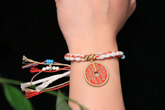In China, whether in bustling cities or quiet rural villages, it's common to see a simple red string wrapped around people's wrists. Though it may appear modest, this humble string carries profound meanings-symbolizing the Chinese people's heartfelt wishes for peace, happiness, and protection. What gives the red string its mystical power? And what cultural secrets lie beneath its surface?
The Red String: From Ancient Beliefs to Everyday Practice
The red string traces its cultural roots to China's ancient "Five Colors Belief" system. According to this philosophy, the five colors-blue, red, yellow, white, and black-correspond to the five elements. Red represents fire, symbolizing brightness, vitality, and the power to ward off evil. Over time, this belief deeply influenced folk customs: red couplets during Spring Festival, red garments at weddings, and red cloth for newborns-all reinforcing red as an auspicious color.
In Taoism, red is believed to repel negative energy ("yin qi"), while in Buddhism, a red string symbolizes a spiritual connection with the Buddha. In the I Ching, red is associated with the "Li" hexagram, representing radiant energy. In ancient times, people wore red strings to boost their personal aura. During the pre-Qin period, red strings were used in sacrificial rituals and later evolved into protective charms—especially popular in one's zodiac birth year ("benmingnian") to ward off misfortune.
Why Wear a Red String? Three Core Meanings
1. Protection Against Evil: The Invisible Guardian
The ancients believed that malevolent spirits feared red's fiery glow, making the red string a natural talisman. Newborns would have red strings tied to their wrists or ankles to "bind good fortune", while those in their zodiac year wore them to avert bad luck. Today, even as superstition fades, the tradition persists-especially during festivals or life milestones-offering psychological comfort and a sense of spiritual security.
2. Blessings and Wishes: A Token of the Heart
The red string often carries personal intentions:
• Love & Marriage: Rooted in the legend of the "Old Man Under the Moon" (Yuelao) who ties destined lovers with a red thread, the string represents romantic fate. Singles wear it to attract love, while couples exchange red strings as a symbol of loyalty.
• Health: Elders wear it to pray for longevity; those who are ill wear it in hope of recovery.
• Wealth: When paired with gold or prosperity charms, the red string signifies "prosperity in full bloom".
3. Identity and Heritage: A Cultural Bond
The red string also carries emotional significance: a family heirloom red string symbolizes lineage and continuity, while red strings exchanged between friends stand for lasting bonds. Among overseas Chinese, wearing a red string subtly affirms their cultural roots and identity.
The Wisdom Behind Wearing the Red String
Despite its simple appearance, there is traditional wisdom in how the red string is worn:
• Material Matters: Pure red cotton string is the most traditional; adding jade beads enhances wellness (jade is believed to nourish), while gold elements attract wealth. A two-tone string (red and black) seeks balance between yin and yang.
• Placement Etiquette: Wearing it on the left wrist invites blessings ("receiving fortune"), while the right wrist is for warding off evil. Ankle red strings offer discreet protection. Around the neck, it's often paired with pendants, blending adornment with spirituality.
• Cultural Taboos: A red string gifted by someone else-especially an elder or obtained from a temple-is considered more spiritually potent. If the string breaks unexpectedly, tradition sees it as having "absorbed misfortune" on the wearer's behalf. It should be respectfully handled, never discarded casually.
⸻
The red string continues to embody the Chinese people's enduring hope for a peaceful and joyful life. More than just a thread, it serves as a bridge across millennia-connecting personal destiny with collective memory. Even when its wearers may not fully understand its origins, the longing for safety, happiness, and harmony has long been woven into the cultural fabric.











